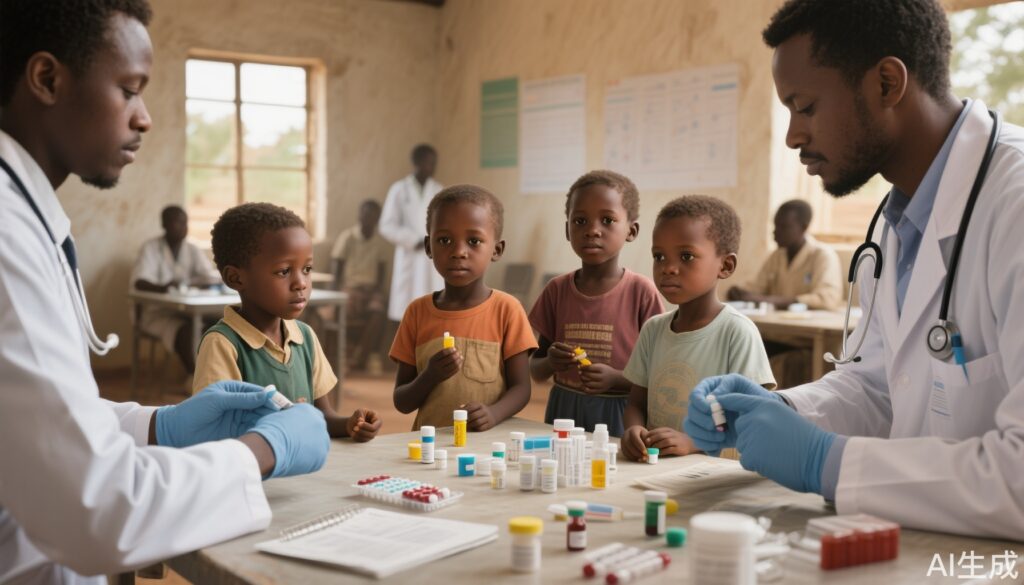Highlights
- Tenofovir alafenamide fumarate (TAF)–emtricitabine backbone was superior to standard care for second-line ART in African children with HIV.
- Dolutegravir anchor therapy achieved higher rates of viral suppression than ritonavir-boosted lopinavir or atazanavir.
- Safety profiles were comparable across regimens, with no significant differences in serious adverse events.
- Ritonavir-boosted darunavir and atazanavir are viable alternatives for second-line therapy.
Clinical Background and Disease Burden
Pediatric HIV remains a major public health challenge in sub-Saharan Africa, where the majority of the world’s 1.7 million children living with HIV reside. First-line antiretroviral therapy (ART) failure is not uncommon, due to factors such as drug resistance, suboptimal adherence, and limited pediatric formulations. Historically, options for second-line ART in children have been constrained, with many regimens associated with suboptimal efficacy, toxicity concerns, and complex dosing. The CHAPAS-4 trial addresses the critical need for evidence-based, effective, and safe second-line regimens tailored for children in these settings.
Research Methodology
The CHAPAS-4 trial was a multicenter, open-label, randomized controlled study employing a 2-by-4 factorial design. Eligible participants were children with confirmed HIV infection and documented virologic failure on first-line ART. A total of 919 children (median age: 10 years; 54.1% male) across Africa were randomized to receive either TAF–emtricitabine or a standard care backbone (abacavir or zidovudine plus lamivudine). These were combined with one of four anchor drugs: dolutegravir, ritonavir-boosted darunavir, ritonavir-boosted atazanavir, or ritonavir-boosted lopinavir. The primary endpoint was the proportion of children achieving a plasma HIV-1 RNA (viral load) of less than 400 copies/mL after 96 weeks of treatment. Secondary endpoints included safety profiles and serious adverse events.
Key Findings
At week 96, the superiority of the TAF–emtricitabine backbone was demonstrated, with a 6.3 percentage point higher rate of viral suppression compared to standard care (adjusted difference, 6.3; 95% CI, 2.0 to 10.6; P=0.004). Notably, the dolutegravir anchor regimen yielded a 9.7 percentage point higher suppression rate than ritonavir-boosted lopinavir and atazanavir combined (95% CI, 4.8 to 14.5; P<0.001). Ritonavir-boosted darunavir, while efficacious, did not meet the prespecified threshold for superiority but was nonetheless effective. Ritonavir-boosted atazanavir was noninferior to ritonavir-boosted lopinavir. Only one child died during the trial, and 3.2% experienced serious adverse events, with no significant differences between groups, underscoring the safety of these regimens.
| Regimen | Participants (n) | Viral Suppression (<400 copies/mL) at 96 Weeks | Key Statistical Outcome |
|---|---|---|---|
| TAF–emtricitabine | 458 | Higher than standard (adj. diff. 6.3%, 95% CI 2.0–10.6) | P=0.004 |
| Standard care (ABC/ZDV + 3TC) | 461 | Reference | – |
| Dolutegravir (anchor) | 229 | Superior to LPV/r & ATV/r (adj. diff. 9.7%, 95% CI 4.8–14.5) | P<0.001 |
| Darunavir/r (anchor) | 232 | Not statistically superior (adj. diff. 5.6%, 95% CI 0.3–11.0) | P=0.04 (threshold 0.03) |
| Atazanavir/r (anchor) | 231 | Noninferior to LPV/r | – |
| Lopinavir/r (anchor) | 227 | Reference | – |
Mechanistic Insights or Biological Plausibility
The increased efficacy of TAF–emtricitabine is consistent with the high potency and favorable resistance profile of tenofovir alafenamide in combination with emtricitabine, both nucleos(t)ide reverse transcriptase inhibitors. Dolutegravir, an integrase strand transfer inhibitor, is known for its high genetic barrier to resistance, once-daily dosing, and favorable safety profile, making it particularly suitable for pediatric populations. Protease inhibitors such as darunavir and atazanavir, especially when boosted with ritonavir, are also potent but may be associated with metabolic and gastrointestinal side effects, which were not found to be limiting in this study.
Expert Commentary
The CHAPAS-4 findings align with growing expert consensus and evolving World Health Organization (WHO) guidelines favoring integrase inhibitor-based regimens for both adults and children. As highlighted by opinion leaders, the ability to offer TAF–emtricitabine and dolutegravir to children in resource-limited settings marks a significant advance in pediatric HIV care, potentially improving long-term outcomes and reducing the burden of treatment failure.
Controversies or Limitations
The open-label design and the exclusion of younger children and infants may limit the generalizability of these findings to all pediatric age groups. Additionally, the study was conducted in clinical trial settings with enhanced monitoring and support, which may not fully reflect real-world resource constraints. Long-term follow-up is needed to assess durability of response and late-emerging toxicities, particularly renal and bone effects associated with TAF.
Conclusion
The CHAPAS-4 trial provides robust evidence that second-line ART regimens consisting of TAF–emtricitabine and dolutegravir are both effective and safe for children with HIV in Africa. These findings support a paradigm shift toward using newer, more potent therapies as standard second-line options, with meaningful implications for pediatric HIV treatment guidelines and programmatic scale-up. Ongoing research should address access barriers and long-term safety, ensuring that all children benefit from these advances.
References
- Musiime V, Bwakura-Dangarembizi M, Szubert AJ, et al. Second-Line Antiretroviral Therapy for Children Living with HIV in Africa. N Engl J Med. 2025 May 15;392(19):1917-1932. doi:10.1056/NEJMoa2404597. PMID: 40367375; PMCID: PMC7617794.
- World Health Organization. Updated recommendations on first- and second-line antiretroviral regimens and post-exposure prophylaxis and recommendations on early infant diagnosis of HIV. Geneva: WHO; 2018.



